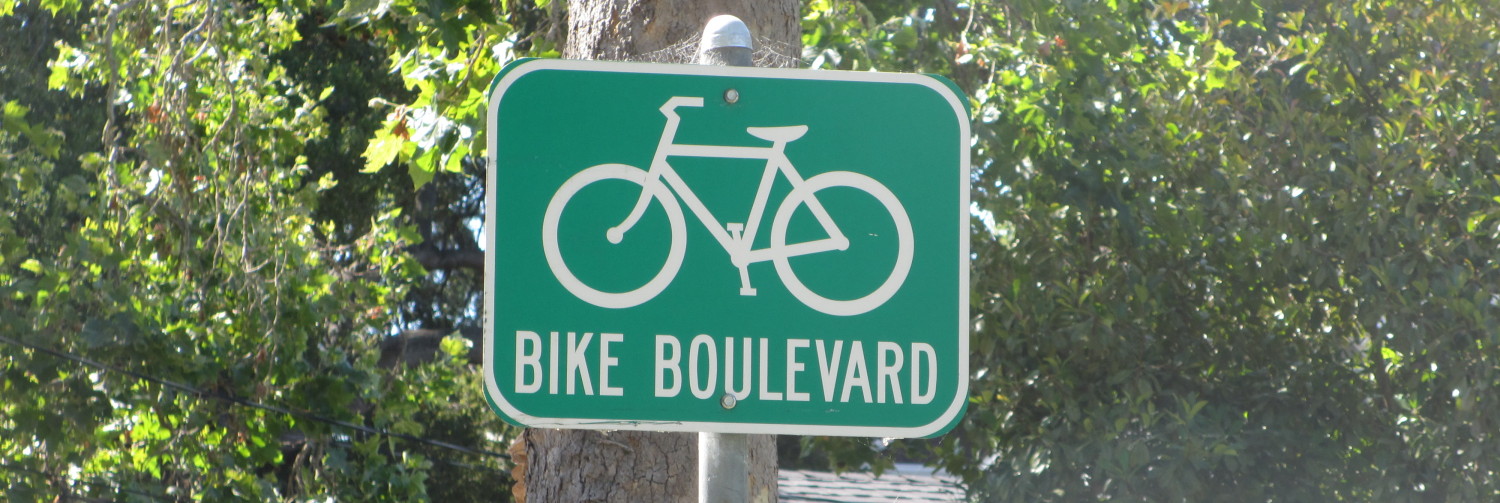I feel that much of what Ottawa does as “traffic calming” is badly compromised by a desire not to inconvenience the motorist at all, while purporting to make the street calmer and safer for everyone else.
Case in point: a traffic calming centre island proposed for Booth near Raymond. The design concept was approved by council years ago, but funding has finally come available. So the traffic engineers get to do the detailed design. Well, that island, you know, is just awful. To get big trucks around it they’d need to widen the road, increase the curb radii at intersections, remove landscaping, encroach on sidewalks, etc etc. Wouldn’t want that “calming” feature to actually slow down or cause motorists to think twice would we?
This traffic calming scene from Germany seemed much more based on the “tank trap” school of thought. Heavy concrete obstacles, regularly placed, force vehicles into a series of sharp turns, a bit like chicanes. It certainly could be prettier, but I suspect it does its job very well.
BTW, this is not a “telephoto” or trick shot, it must be obvious by now I am still a Kodak brownie-level photographer. Here is another bit of serious traffic calming, and very green too:





I have a problem with traffic calming measures that force cyclists out into the roadway. When vehicles converge at the narrow points, the motorists invariably view themselves as having the lane and that it is the cyclists who are moving into their space.
Many drivers will happily try to squeeze themselves past the cyclist at full speed with greatly reduced separation. If you want to try this for yourself, ride a few lengths of Kirkwood Avenue between Carling and Richmond . Lately they have been working on that stretch but it looks to me like they’re preserving the cyclist-hostile design.
Obstacles in the middle are better because at least they force the driver to change course. However, the pinch points are still unnerving for cyclists and pedestrians, especially when there is still ‘room’ for the driver to pass, because you know they will – braking is so tedious!. The second picture makes sense because the driver clearly has to wait for a clear road before proceeding.
In ontario, we tend to build wide-ish traffic lanes, expecting cars and cyclists to share these, similtaneously. Where lanes are narrow, eg west wellington, this gets very uncomfortable for cyclists, who do get squeezed. And side obstructions force cyclists into the “main” lane. It is easy to say “cyclist, take the whole lane” but is harder to actually do. Sharrows painted off to the side seem too often to encourage cyclists to be gutter bunnies. Maybe sharrows painted in the centre of the lane? Or road designs that actively discourage speeding?
COMMENT CONT’D: What ever measures are taken, isolated narrowings and calming measures are justifiable only as the “first steps” to traffic taming, What is needed is a complete redesign with different objectives. But we aren’t going to get that tomorrow, so on with the little measures, bit by bit.
It was sad on CBC Ottawa Morning the other day when they were talking about the secret alternate routes out of Orleans, now that there is so much construction. It reminded me of all he idiots speeding down our side streets during the Preston construction years. How many kids have to be run over, so that civil servants can get to work on time 🙁
Eric –
What are the laws in Europe regarding being a cyclist and being struck by a car?
JUst thinking of Steve’s comment above and I have to agree with him that drivers do not see cyclists as legitimate road users and create dangerous situations for them. I also get teh feeling that our laws, and law enforcement, are biased in favour of the driver.
Europe has a higher percentage of cyclists. Do the laws there act to protect cyclists from drivers and thereby create a safer environment for all roadway users?
Also – the artist that built those red benches created some very lifelike sculptures.
Another objection I’m sure the traffic engineers here would offer against such designs would be winter snow clearing considerations. Just looking at them, I would think the graders we use for snow clearing could take out most of them (and they’re not marked, either, which definitely wouldn’t happen here).
It’s quite frustrating that designs used elsewhere in the world, typically Europe, “can’t” be implemented here in Ottawa, or Ontario, or Canada, or North America, because we “need” to allow for the passage of giant vehicles, be they fire engines, garbage trucks, snow plows or tractor trailers. For instance, the building code’s requirements for on-property fire lanes require those lanes to be bigger than many streets in the rest of the world, and even a few here (e.g. Shannon St near the former convent in Westboro).
The unfortunate side effect of accommodating these big vehicles is that it enables drivers of the far more numerous and smaller cars to speed through everything, and discourages people from cycling and walking.